萨拉文化中心,谢莱夫特奥,瑞典
白色建筑事务所
客户:谢莱夫特奥市政厅
主持建筑师:Oskar Norelius,Robert Schmitz
设计团队:Maria Orvesten,Patrik Buchinger,Amanda Ersson,Gustav Söderlund Röstberg,Jens Hansson,Magdalena Stål,Maria Laakso,Mats Selin,Milla Nyström,Nils Arvid Wiking,Agne Revellé,Martina Sovré,Gunnar Hidemark,Katarina Eurenius,Erik Falkenström,Solveig Sennerholm,Jesper Källgren,Christoffer Sundberg,Pernilla Svedberg,Viktor Sjöberg,Sarah Dahman,Axel Bodros Wolgers,Anders Johansson,Björn Vestlund,Anton Magnusson,Charles Gårdeman,Marte Noedtvedt Skaeggestad Sam Keshawarz,Karl Tyrväinen,Andreas Ivarsson,Ulrika Wallin,Björn Norén,Marianne Rutberg,Pontus Stigeborn
结构工程师:DIFK AS,TK Botania,WSP AB
Client:Skellefteå Municipality
Principal Architects:Oskar Norelius,Robert Schmitz
Design Team:Maria Orvesten,Patrik Buchinger,Amanda Ersson,Gustav Söderlund Röstberg,Jens Hansson,Magdalena Stål,Maria Laakso,Mats Selin,Milla Nyström,Nils Arvid Wiking,Agne Revellé,Martina Sovré,Gunnar Hidemark,Katarina Eurenius,Erik Falkenström,Solveig Sennerholm,Jesper Källgren,Christoffer Sundberg,Pernilla Svedberg,Viktor Sjöberg,Sarah Dahman,Axel Bodros Wolgers,Anders Johansson,Björn Vestlund,Anton Magnusson,Charles Gårdeman,Marte Noedtvedt Skaeggestad Sam Keshawarz,Karl Tyrväinen,Andreas Ivarsson,Ulrika Wallin,Björn Norén,Marianne Rutberg,Pontus Stigeborn
谢莱夫特奥市位于瑞典北部的北极圈内,有着悠久的木制建筑传统。这一传统构成了萨拉文化中心在项目国际竞争中脱颖而出的主要设计灵感,其口号是肩并肩。新的文化中心由市政府发起,被视作使谢莱夫特奥成为一个更有吸引力的地区的关键驱动力。建筑的选址和内容设计都通过市民对话向民众公布,公众还被邀请对国际建筑竞赛中的提案进行投票和评论,其意见形成总结供评委会参考。
随着时间的推移,斯凯莱夫特奥市中心日益现代化,许多木制房屋消失了。萨拉文化中心位于城市最中心的地块上,将文化和木材带到城市的核心。它由不同规模和透明度的木制结构组成,在街道层面上呈现出宜人的尺度,较低的体量面向狭窄的街道,错落有致地延伸至面对主广场的地标性酒店。方案的每一部分都由一个简单合理的体量来描绘,与内容相适应。不同的体量组成了文化中心的整体,同时减少了建筑的整体规模。
萨拉文化中心被设计成向各个方向开放,以激活它周围的街道。通常隐藏在幕后的作坊和工作室是开放的,从街上可以看到,这独特地展示了创作过程背后的工艺。开放式的布局与宽敞的玻璃窗相结合,向路人展示了里面的活动。黑匣子舞台的尺寸可供大型国际剧目进行表演,而非正式的展览和活动则可以安排在文化中心设计灵活的大厅中。
建筑物的位置,加上周围公共场所的规划和有许多入口的透明外墙,共同降低了进入建筑物的门槛,以一个开放和欢迎姿态的建筑物取代了严肃的文化机构形象。设计的目标是让每个人都感觉自己受到邀请,并能自如地进入。项目位于一个斜坡上,整个设计基于两个平坦且完全无障碍的底层,可以从四面八方轻松到达,而内部布局的设计更是为了方便人们寻找路线。在主入口处,建筑的核心是一个大楼梯,可以俯瞰文化中心的所有活动。这个空间是中性的,可以作为一个城市客厅,也可以当作当地居民的一个“讲演角”。这个未经规划的公共空间欢迎所有市民和来访者加入正在进行的文化对话中。
Located just below the Arctic Circle in northern Sweden,the city of Skellefteå has a long tradition of timber buildings.This tradition formed the primary inspiration behind the winning design in the international competition for Sara Culture Centre,under the motto "Sideby-side".The new culture centre was initiated by the municipality to act as a key driver in making Skellefteå a more attractive region.Citizen dialogues were held to inform both the choice of site in the city as well as the content of the building.The public was invited to vote and comment on the proposals in the international architecture competition,with a summary of public opinion provided to the jury.
Over time,as Skellefteå's city centre was modernized,many wood houses disappeared.Placed on the city's most central plot,Sara brings culture and wood to the core of town.It is composed of timber volumes of varying scales and transparency combined to give a human scale at street level with lower volumes toward narrow streets,staggering up to the landmark hotel facing the main square.Each part of the programme is portrayed by a simple rational volume,adapted to the content.The composition of the individual volumes forms the whole of the cultural centre while reducing the overall scale of the building.
Sara Cultural Centre was designed to open up in all directions to activate the streets around it.Workshops and ateliers,usually hidden behind the scenes,are open and visible from the street,uniquely showcasing the craft behind the creative process.Open layouts combined with generous glazing reveal the activities inside to passers-by.The black box stages are dimensioned to bring the largest international productions to town,while informal exhibitions and events can be programmed throughout the centre's flexible foyers.
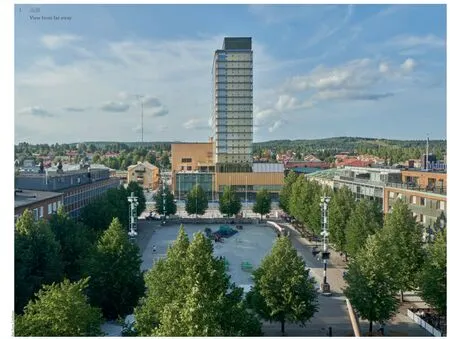
1 远景View from far away
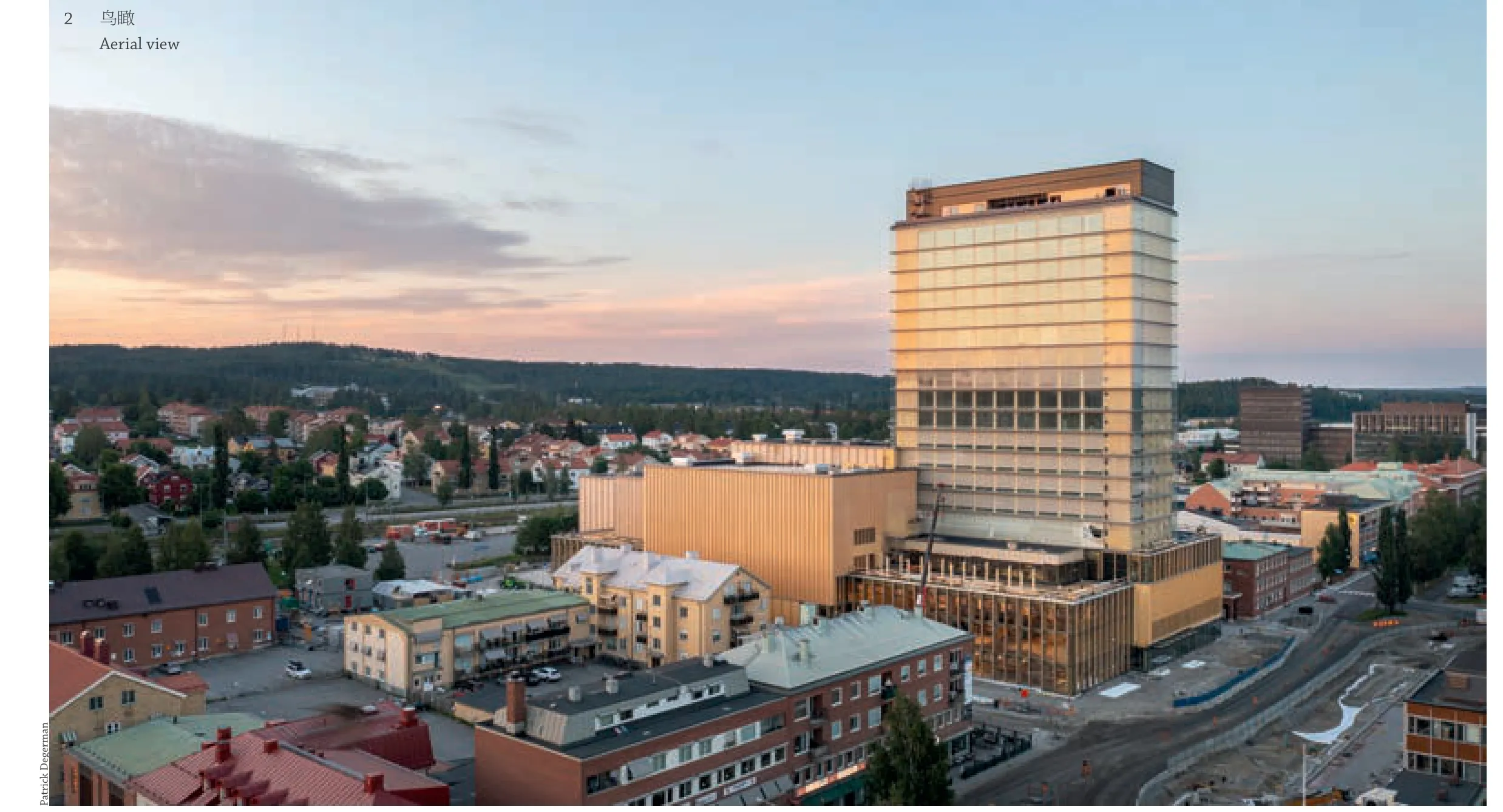
2 鸟瞰Aerial view
顾问:Incoord,Brandkonsulten,Artifon
总承建:HENT
结构体系:Timber structure
材料:Cross Laminated Timber,Glue Laminated timber
场地面积:5500m2
使用用途:文化中心,酒店
总建筑面积:28,000m2
建筑高度:75m
造价:105M EUR
设计时间:2016-2021
施工时间:2019-2021
竣工时间:2021.09
绘图:白色建筑事务所
摄影:Åke Eson Lindman,Jonas
Westling,Patrick Degerman,Sven Burman

3 总平面 Site plan
作为一个公共建筑,该项目旨在丰富社区,而其多样化的设计更进一步提升了城市的文化环境。通过在一栋建筑中结合多种功能从而产生新的合作机会,萨拉文化中心具有对社区产生更大影响的潜力。酒店及其设施进一步增强了这一效果,它成为一个新的目的地,吸引着区域内、国内和国际的游客,并为当地居民提供了新的可能性。
项目设计以共享为出发点,虽然为了减少项目的建筑面积,每个单独活动的空间已经减少到其理想需求的大约70%。但是通过文化中心管理方促成的共享协议,每个项目都可以获得其理想面积需求的130%以上的空间。大楼的灵活规划可以为大型活动连接起空间,或为平行举行的活动分割成较小的空间。这种灵活性也允许建筑随着时间的推移适应需求和实践的发展,确保其与各种未来活动保持相关性。
通过让木材重新成为城市结构中的一种材料,萨拉文化中心确认了斯凯莱夫特奥的木材使用传统和当地的木材产业的地位。它还通过从距离建筑工地约100km 半径内的可持续森林采购,并在距离工地约50km 的锯木厂进行加工来为这一产业的发展做出贡献。该建筑将木材作为一种巨大的结构性材料来使用,而不是仅仅将其作为饰面层。木材元素成为建筑表达的一部分,使其可见和可读,激发了人们对了解该建筑如何组装起来的兴趣。裸露的天然木材会随着时间的推移而老化,高层建筑的木材核心结构可以透过反射着北欧天空的双层外墙看到。萨拉文化中心的面积约30,000m2,是世界上第一个达到20 层的木结构。□(钱芳 译)
评审评语(1)
萨拉文化中心位于瑞典北部,恰好在北极圈以下。建筑具有多种功能:会议中心、展览空间、图书馆、酒店、餐厅和公共管理空间。项目所在的谢莱夫特奥市是一座中等规模的城市,有悠久的木构建筑历史。萨拉文化中心延续了这一传统,它是使用木材作为结构材料的全球最高建筑之一。萨拉文化中心是一个具有标志性的先锋项目,它也改变了这座小城市的尺度,在严寒的气候环境中为人们提供许多受欢迎的社会和文化设施。凭借多元复合的功能,它让人们能够参与日常难以接触到的丰富活动之中。它还为夏季提供了室外的公共空间,因此这是一个非常有吸引力、有共情力和值得赞扬的项目。(母卓尔 译)
评审评语(2)
项目充分展现了木构建筑的魅力,它不仅创造了木结构建筑的最新高度,而且还采用了3D 模块装配式技术,这对我们探索建筑的低碳发展提供了很好的样板。其规则的体量和简洁的立面,呈现出朴素的构建逻辑和新的现代性风貌,这与展现非线性和复杂化形成对比,让我们更加关注由建筑技术展现出的艺术魅力。这座建筑还因为它的开放性,改变了城市空间对市民的影响力,使城市中心区域得以扩展,让文化和艺术通过建筑空间融入到人们的生活中。
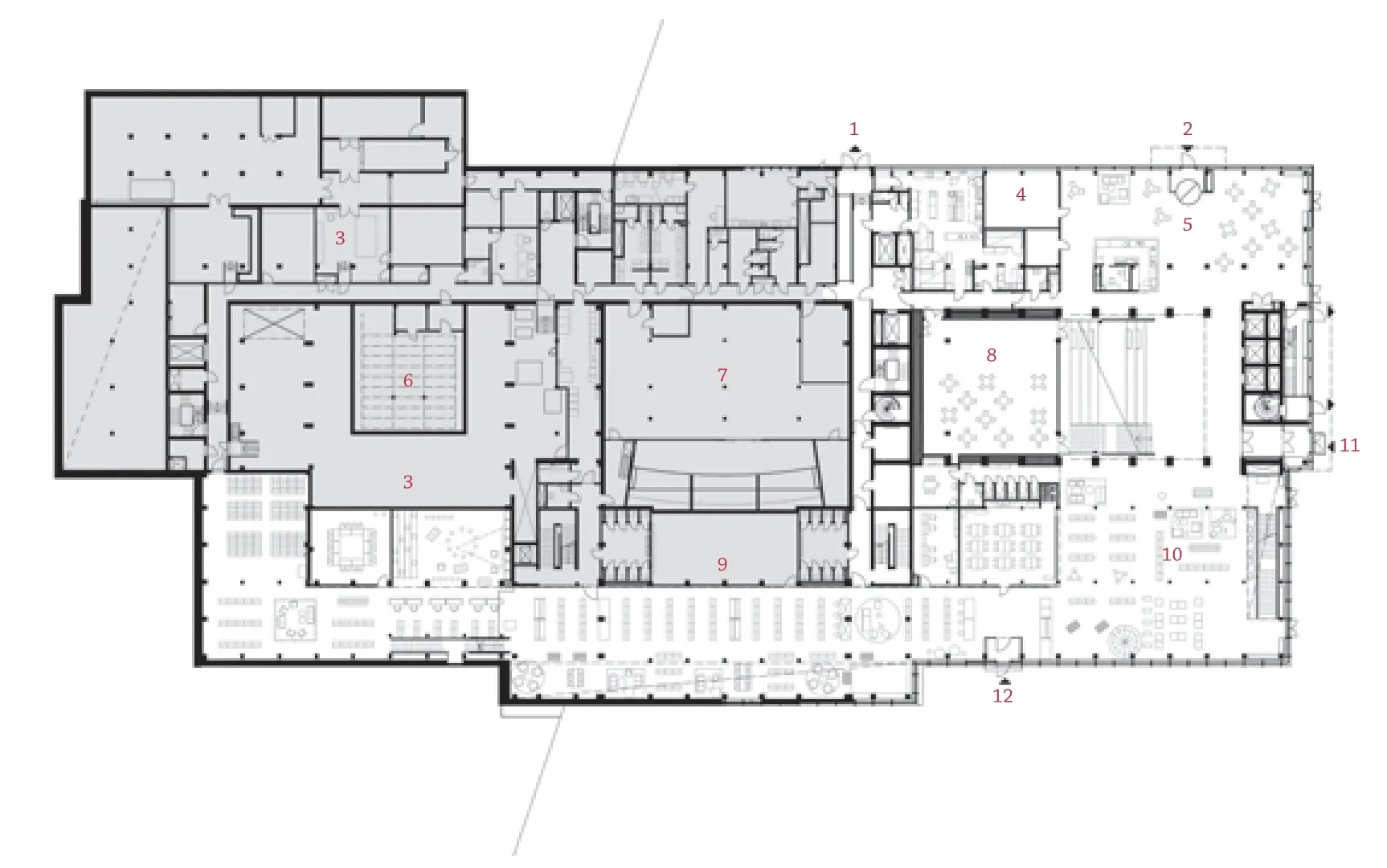
4 首层平面Ground floor plan
Structural Engineers:DIFK AS,TK
Botania,WSP AB
Consultants:Incoord,Brandkonsulten,Artifon,
General Contractor:HENT
Structural System:Timber structure
Material:Cross Laminated Timber,Glue Laminated timber
Site Area:5500 m2
Function:Culture Centre,Hotel
Total Floor Area:28,000 m2
Height:75 m
Cost:105M EUR
Design Period:2016-2021
Construction Period:2019-2021
Completion Time:2021.09
Drawings:White Arkitekter
Photos:Åke Eson Lindman,Jonas
Westling,Patrick Degerman,Sven Burman
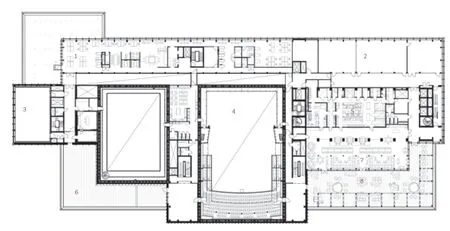
5 四层平面Third floor plan
The location of the building,together with the programming of the surrounding public places and the transparent facades with many entrances,work together to lower the threshold to enter the building and replacing the image of an austere cultural institution with an open and welcoming building.The goal is for everyone to feel invited,and at ease to enter.Located on a slope,the entire design is based on two flat and fully accessible ground floors that can be easily reached from all sides while the internal layout is designed for easy way finding.At the main entrance,at the heart of the building is a great staircase that overlooks all activities of the culture centre.This space is neutral and works as an urban living room and can function as a "speaker's corner" for the inhabitants.The unprogrammed public space welcomes all citizens and visitors to participate in an ongoing dialogue on culture.
As a public building the project aims to enrich the community,and the diverse programme strengthens the city's cultural environment.With the opportunities for collaboration that arise when combining many functions in one building,Sara offers the potential of an even greater impact on the community.The hotel with its amenities further adds to this equation,forming a new destination attracting visitors regionally,nationally,and internationally as well as offering new possibilities for residents.
Designed with sharing as a starting point,to reduce the project's floor area,the space of each individual activity has been reduced to approximately 70% of its ideal needs.But through a sharing agreement facilitated by the cultural centre's management,each programme has access to over 130% of their ideal surface needs.The flexible programming of the building allows connecting spaces for very large events or dividing into smaller fractions for parallel events.This flexibility will also allow the building to adapt over time as needs and practices evolve,ensuring its future relevance as a framework for activities.
By bringing back timber as a material in the urban fabric,Sara acknowledges Skellefteå's historic timber tradition and local timber industry.It also promotes it by sourcing from sustainable forests located within an approximately 100 km radius from the building site and processing in a sawmill approximately 50 km from the site.The building is realised with timber as a massive,structural material,not a surface layer on top of something else just for show.Timber elements become part of thearchitectural expression making them visible and readable,triggering an interest in how the building is assembled.Exposed natural wood will age over time while the timber core structure of the high-rise is visible through a double-skin façade reflecting the Nordic sky.Sara comprises approximately 30,000 m2and the first timber building in the world to reach 20 stories.□
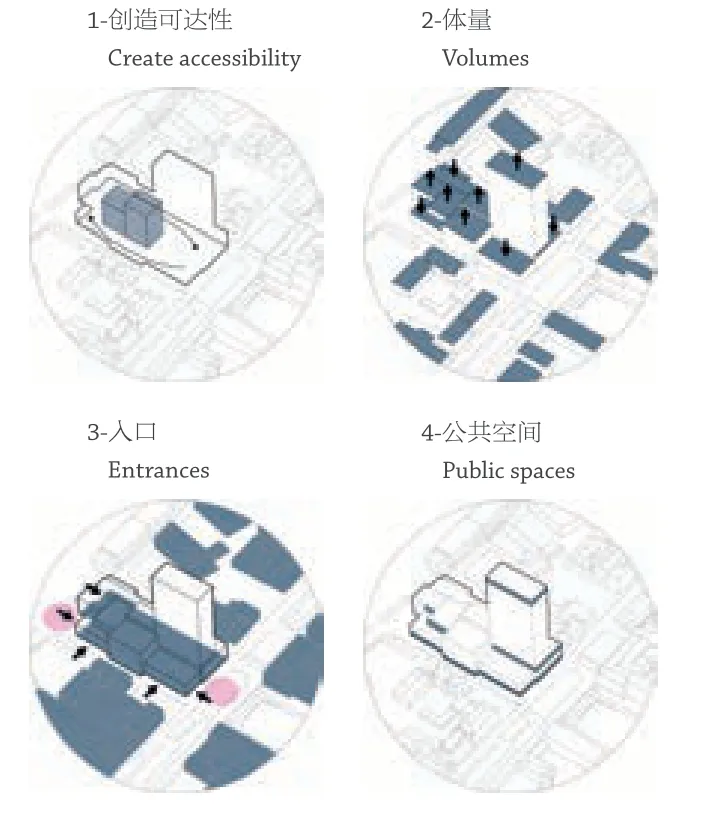
6 图解分析Diagram analysis
Jury Statement (1)
The Sara Culture Centre is situated in Northern Sweden,just below the Arctic Circle.The centre comprises multiple functions:auditoriums,exhibition spaces,a library,a hotel,a restaurant and spaces for public administration.As the medium-sized town of Skellefteå has a long history of timber construction.The Sara Culture Centre,being one of the tallest buildings worldwide,that use timber as structural material,continues this tradition.Sara is an apparent symbol and pioneering project of architecture,but it also completely changes the scale of this small city and provides much welcome social and cultural amenity in a very harsh climate.With its rich variety of programmes,it connects people to activities which hitherto might have been out of their reach.Offering also outside public spaces for the summer months this makes a very attractive,empathetic and commendable project.
Jury Statement (2)
The Sara Culture Centre demonstrates the fascination of timber frame architecture,not only by creating the latest heights in timber frame construction,but also by using 3D modular assembly technology,which provides a good model for our exploration of low carbon development in architecture.The regular form and simple façade of the Sara Culture Centre present a basic logic of construction and a new style of modernity,which contrasts with the non-linearity and makes us pay more attention to the artistic appeal shown by the building technology.The building also increases the influence of urban space due to its openness,allowing for the expansion of the city centre area and integrating culture and art into people's lives.
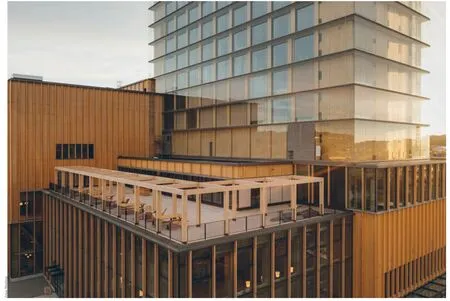
7 屋顶露台Roof terrace
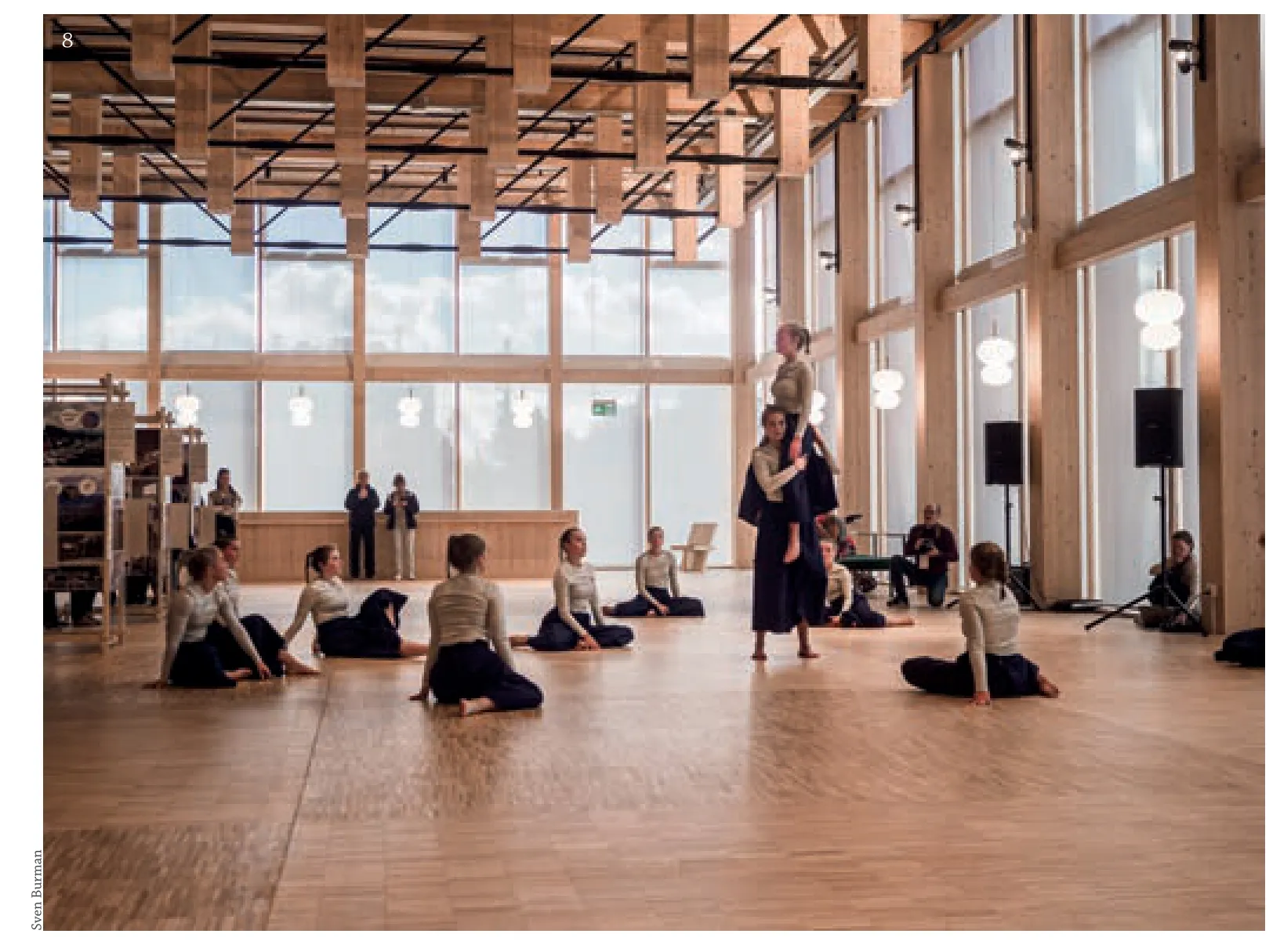
8 开放日活动Sara Openinng
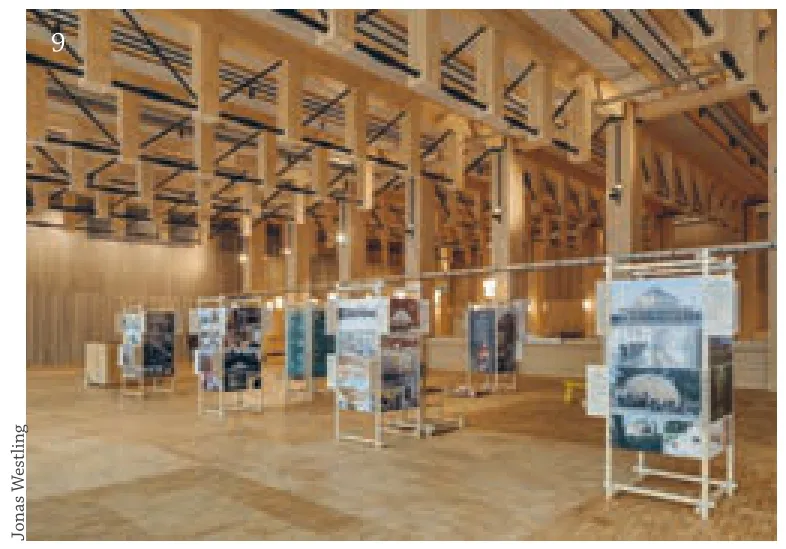
9 展览Exhibition
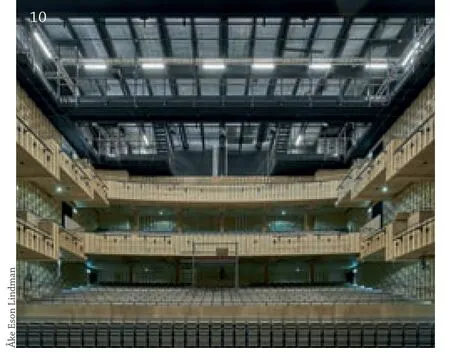
10 舞台Stage
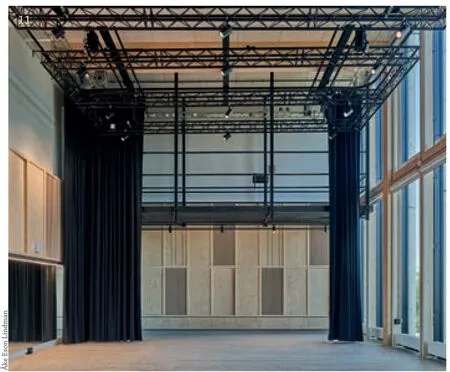
11 舞蹈教室Stage Trap Room
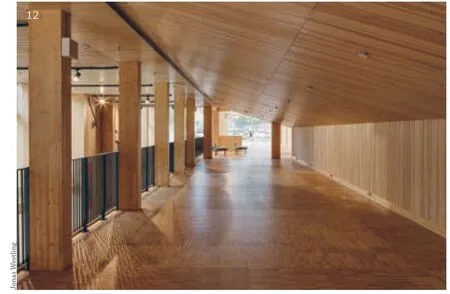
12 艺术门廊Artist foyer
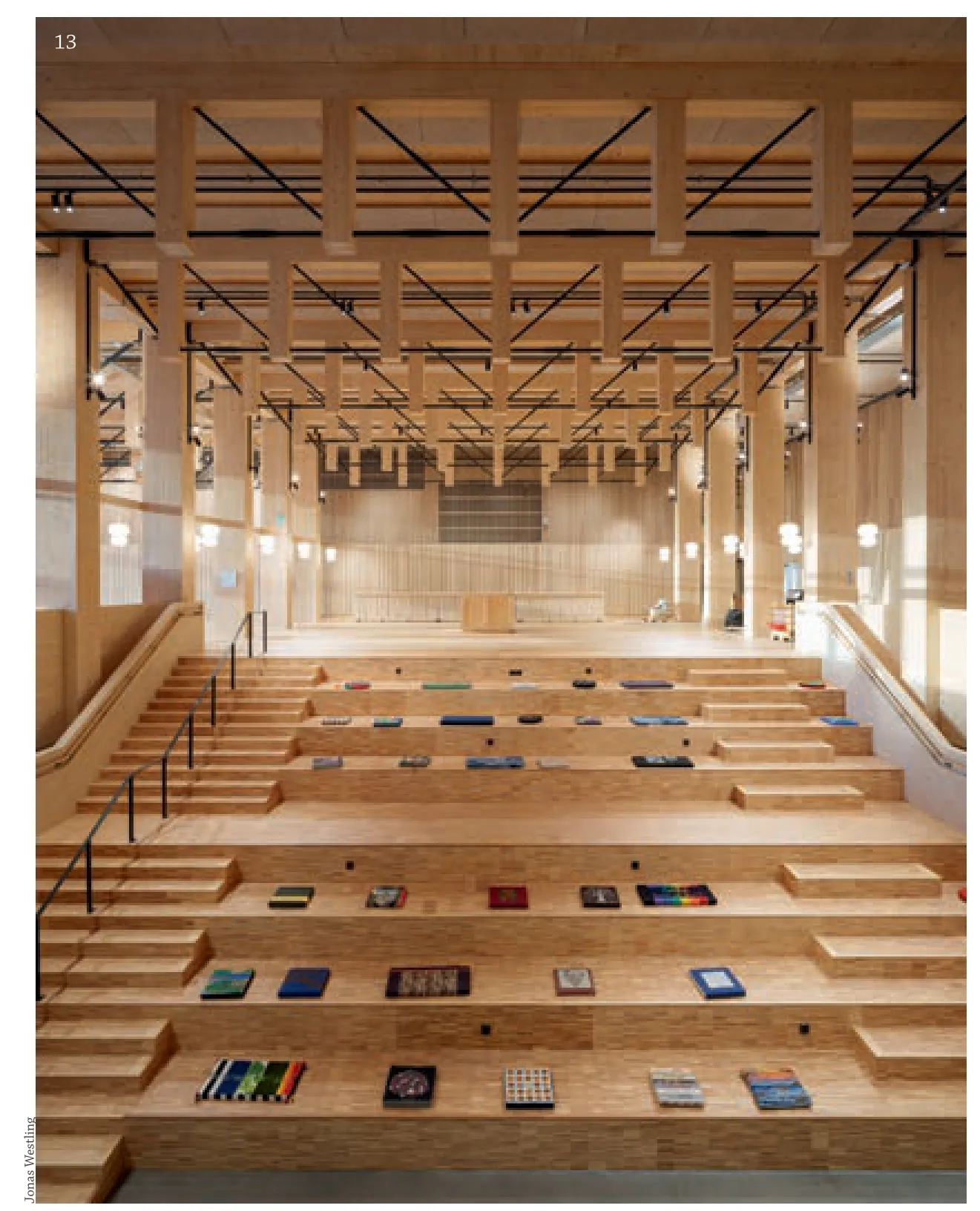
13 开放空间Open space
——以浙江省为例

